Adromischus leucophyllus
Adromischus leucophyllus Uitewaal
Family: Crassulaceae
Common names: flour-stonecrop, white-leaf adromischus (Eng.); witblaarplakkie, meel-boekplakkie (Afr.)
Introduction
The flour-stonecrop is a dwarf, cluster-forming to pendent leaf succulent from the mountainous regions between Barrydale, Montagu, Robertson and De Doorns in the Western Cape, with pale whitish, rounded and flattened leaves that grow crowded at the branch tips and small tubular white flowers in summer. Best grown in containers and easily propagated from detached leaves.
Fig. 1. A hanging cluster (left) and a young plant (right) of Adromischus leucophyllus growing on shady quartzitic sandstone cliffs near De Doorns, in Robertson Karoo vegetation. Note the leaves densely covered in a powdery bloom. Plants grow in crevices and ledges, mostly well protected from browsing herbivores and tortoises.
Description
Description
Dwarf-sized, sparsely branched, spreading, succulent herb, up to 55 × 130 mm. Roots fibrous, often stilt-like, from the stems. Stems 2–6 mm in diameter, succulent, at first grey-green with powdery bloom, becoming brownish, up to 6 mm in diameter at base. Leaves 10–30 × 8–25 mm, dorsiventrally compressed, obovate to suborbicular, very brittle, grey to whitish green, and covered in a powdery bloom, occasionally with few purplish spots, usually without spots (immaculate), young leaves green, shiny; margin horny, acute, decurrent on petiole. The upper surface flat to convex; lower surface convex and rounded at the leaf end. The base wedge-shaped.
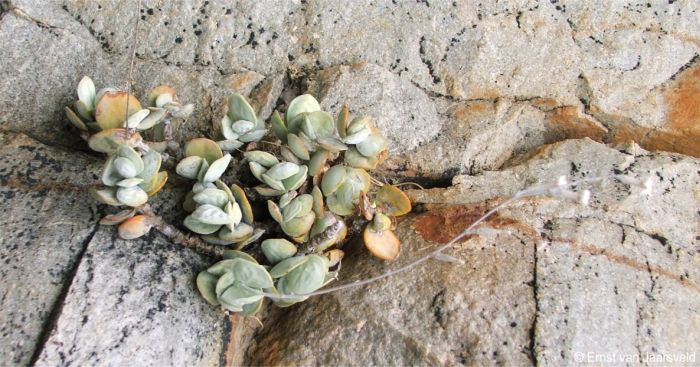
Fig. 2. A cluster of Adromischus leucophyllus in flower on a crevice of a cliff near De Doorns, Western Cape.
The Inflorescence consists of an erect spike-like thyrse up to 150 mm long, bearing 1–4-flowered cymes, the buds ascending, terete and tapering. The calyx 2.0–2.5 mm long. The flowers (corolla) are cylindrical, 11–13 × 3 mm, slightly widening upwards, the floral lobes triangular-lanceolate, white with pink median stripes, and with club-shaped glandular hairs near the end. The anthers not protruding. Flowering is in summer (November to February). Seeds are minute, released in autumn.
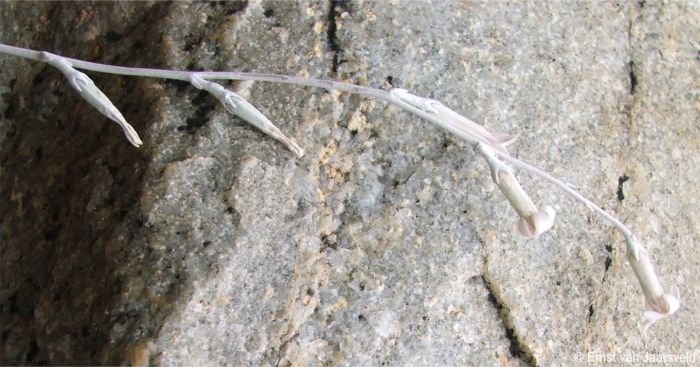
Fig. 3. A close-up of the inflorescence of Adromischus leucophyllus near De Doorns, Western Cape.
Conservation Status
Status
Assessed as Least Concern (LC) by the Red List of South African plants, Adromischus leucophyllus is a range restricted habitat specialist which is not threatened (Raimondo et al 2009).
Distribution and habitat
Distribution description
Adromischus leucophyllus grows on quarzitic sandstone cliffs of the Table Mountain and Witteberg Group (Cape Supergroup), usually in partially shady kloofs and on steep mountain slopes as well as on mountain summits, between Montagu, Robertson and Barrydale in the Klein Karoo and De Doorns in the Laingsburg District in the east. Plants grow on all aspects but more on cooler southern aspects. In summer the temperature may reach 40°C. Winters are cooler but frost is absent. The average daily maximum temperature is about 25°C and the average daily minimum about 10°C. Rainfall can occur in summer (convectional) and winter (frontal systems), ranging from 200–400 mm per annum. A. leucophyllus grows at altitudes of between 500–1 000 m. The associated vegetation includes Robertson Karoo and a mosaic of South Sonderend Sandstone Fynbos (Mucina et al. 2006).
Near De Doorns Adromischus leucophyllus grows in crevices and ledges and shares its habitat with Adromischus filicaulis subsp. marlothii, Aloe perfoliata, Crassula badspoortense, Crassula muscosa var. muscosa, Crassula nemorosa, Crassula perforata, Cotyledon orbiculata, Haemanthus coccineus, Nerine ridleyi, Oxalis pocockiae, Curio crassulifolius, Senecio junceus and Crassothonna cacaloides (= Othonna carnosa).
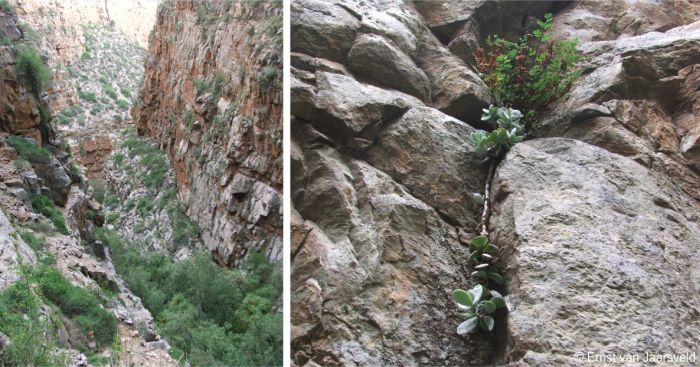
Fig. 4. The cliff face habitat, near De Doorns in the Western Cape (left). (right) An old specimen of Adromischus leucophyllus becoming pendent with age, the stem about 30 cm long , sharing its safe crevice habitat on the shady cliff with a Karoo fern, Cheilanthes sp.
At Suurkloof, south of Matjiesfontein, plants grow in crevices of rocks, boulders and cliffs and at the top of ridges. The leaves sometimes purplish spotted. Here the plants grow in dry Fynbos in association with Agathosma ovata, Antimima sp., Haworthia wittebergensis, Aloe microstigma, Lobostemon sp., Dodonaea viscosa var. angustifolia, Roepera foetida (= Zygophyllum meyeri) and Lampranthus affinis.
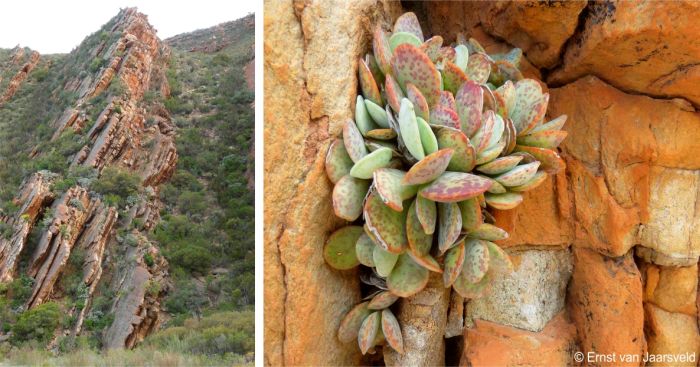
Fig. 5. The Witteberg quartzite mountain ridges at Suurkloof, near Montagu, habitat of Adromischus leucophyllus and a plant with purple-spotted leaves growing on a cliff ledge.
At the Buffelspoort, later becoming the Gouritz, in the the Klein Karoo, plants grow with Astroloba cremnophila, Cotyledon orbiculata, Crassula rupestris subsp. marnierana, Aloe perfoliata, Crassula cultrata and Albuca buffelspoortensis.
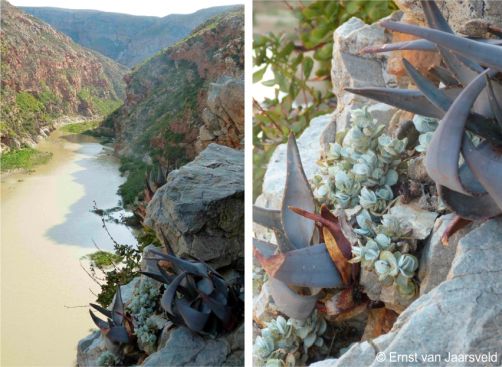
Fig. 6. Adromischus leucophyllus growing among Aloe perfoliata and Crassula cultrata on cliffs at Buffelspoort near Laingsburg.
Near Montagu plants were observed growing with Aloe perfoliata, Haworthia arachnoidea, Crassula rupestris, Anacampseros retusa, Tylecodon paniculatus and Leonotis ocymifolia.
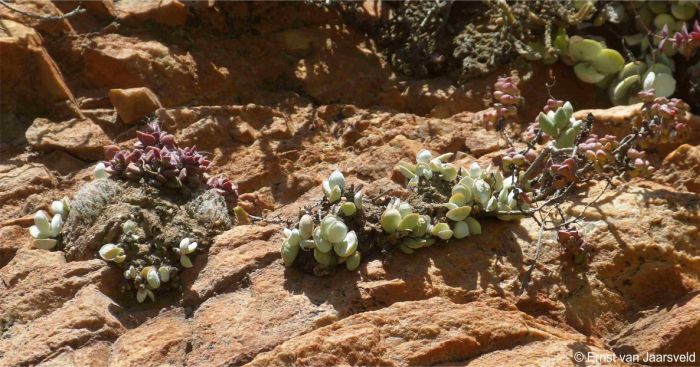
Fig. 7. Adromischus leucophyllus on a more exposed est-facing cliff near Montagu in the Western Cape, sharing its habitat with Adromischus filicaulis subsp. marlothii, Anacamperos retusa, Haworthia arachnoidea and Crassula rupestris.
Derivation of name and historical aspects
History
Adromischus leucophyllus was named by the Dutch botanist, Antonius Josephus Adrianus Uitewaal (1899–1963) in the National Cactus and Succulent Journal in 1943 from live plants collected at Montagu by the botanist Tony Hall, of which the live specimens were deposited at Kirstenbosch National Botanical Garden (855/33) where the plants were grown in the succulent collection. The botanical name given by Uitenwaal is of Greek origin ‘leukos’, meaning ‘white’, and phyllon, meaning ‘leaf’, alluding to the pale leaves covered with a whitish bloom (pruinose).
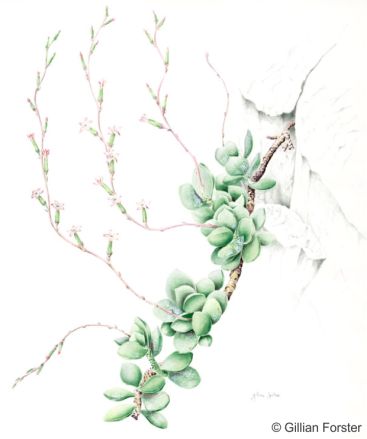
Fig. 8. Illustration of Adromischus leucophyllus by the botanical artist, Gillian Forster from plants growing near De Doorns, Western Cape.
Adromischus leucophyllus superficially resembles A. subdistichus, another cliff-dwelling (cremnophyte) succulent from the eastern Klein Karoo and western extreme of the Baviaanskloof, but the latter is without the pale white leaves. Adromischus leucophyllus varies considerably in size, with a dwarf-sized form on the Warmwaterberg, near Barrydale, the easternmost record, to a robust, larger than average population at Keurkloof, near De Doorns.
Adromischus leucophyllus belongs to section Longipedunculati which was named by Von Poellnitz in 1940. This section which consists of 5 species is distinguished by its glaucous green corolla tube of which the lobes are lanceolate-triangular, erect, spreading or recurved and the anthers not protruding. Members of this section include A. cooperi, A. cristatus, A. leucophyllus, A. marianiae and A. subviridis.
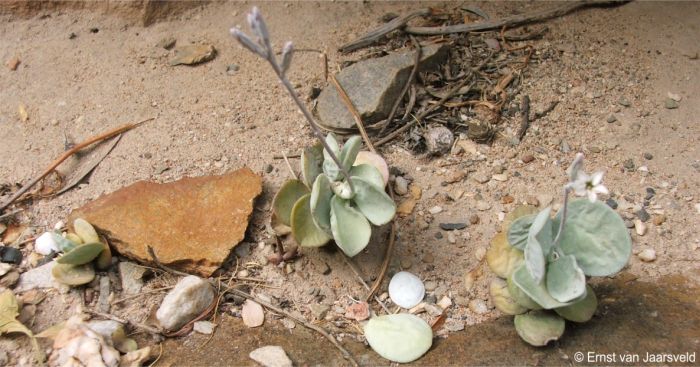
Fig. 9. Plants of Adromischus leucophyllus in flower growing on a broad ledge on a cliff near De Doorns.
Ecology
Ecology
Adromischus leucophyllus is well adapted to crevices on ridges as well as ledges on the vertical habitat on the cliff where it experiences little competition from other plants. Its succulent nature enables the plant to withstand periods of drought and also to rapidly take up moisture which is stored in its leaves. During droughts the leaves become thin. Plants form loose, sparsely branched clusters, often becoming drooping on shady cliffs and with branches to about 200 mm long.
The leaves are orbicular, vertically oriented and covered in a powdery waxy bloom. This pale colour and orientation protects the plants from excessive sunlight and prevents too much transpiration in the xeric rocky ridges and cliff-face environment. The leaves are succulent, storing water and becoming turgid after rain.
The leaves easily become detached with disturbances. Adromischus species generally regenerate rapidly from detached leaves and the same is true for A. leucophyllus. This behaviour is an effective vegetative reproductive backup strategy, ensuring its long-term survival. Plants also increase vegetatively by the branches rooting where they touch the soil, an efficient vegetative dispersal strategy in the nutrient-poor quarzitic sandstone habitat.
Flowering is in summer (November–January), the flowers pollinated by insects. The seed capsules ripen in autumn, the light seeds becoming airborne when blown from the open seed capsules. The seeds are minute and dispersal coincides with the autumn and winter rains.
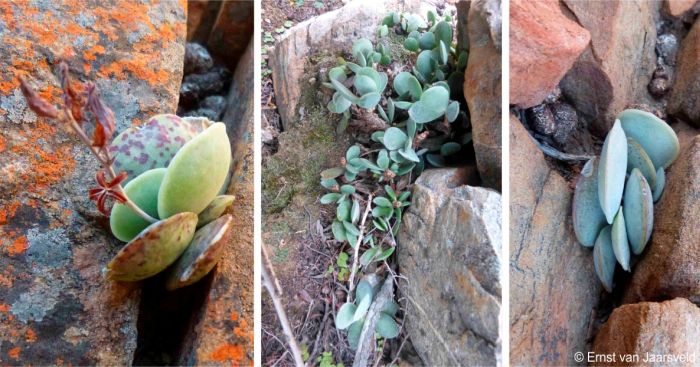
Fig. 10. A young Adromischus leucophyllus plant in fruit (left), (centre) an older plant becoming pendent and (right) a plant on a mountaintop, at Suurkloof, Montagu, Western Cape.
Uses
Use
Only known for its ornamental horticultural use.
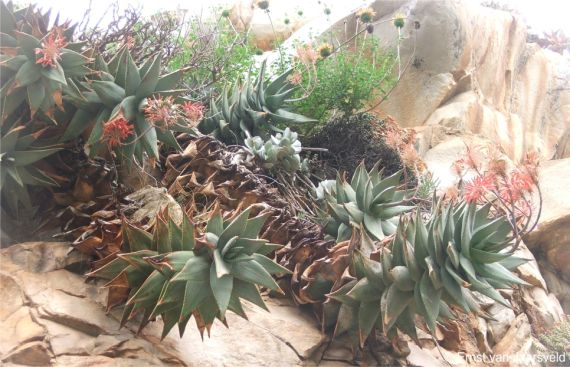
Fig. 11. A cluster Adromischus leucophyllus growing among Aloe perfoliata and Leonotis ocymifolia, near Montagu, Western Cape.
Growing Adromischus leucophyllus
Grow
Adromischus leucophyllus is an easily grown, popular, dwarf succulent, its compact pale whitish leaves, making it an attractive ornamental pot plant. Best for small containers for window sills and stoeps. Like most species of Adromischus, it is a slow grower and best for dappled shade. It is also a valuable in a miniature succulent garden. Plants grow well in a general succulent soil mixture, such as 2 parts sand, 1 part garden loam and 1 part peat or well broken down compost. Good drainage is essential.
Outside its mild Mediterranean-climate habitat, it is best grown under controlled conditions in a greenhouse. In temperate climates, the plant can be moved out of doors for the summer period. The plant grows naturally on mineral-poor acidic sandstone soil.
Propagate from leaf cuttings during the warmer parts of the year. Detach lower leaves and allow the leaf to callus on a dry shady window sill. Once aerial roots appear it can be planted in shallow sandy soil mixture. Keep moist until well rooted. Rooting will take place within 3 weeks.
Sow seed in autumn or winter in shallow trays in a sandy soil. Cover the seed with a thin layer of sand (1-2 mm) and keep moist.
References
- Johnson, M.R., et al. 2006. Sedimentary rocks of the Karoo Supergroup. In M.R. Johnson, C.R. Anhaeusser & R.J. Thomas (eds), The geology of South Africa: 463–501. Geological Society of South Africa, Johannesburg Council for Geoscience, Pretoria.
- Mucina, L. & Rutherford, M.C. (eds) 2006. The vegetation of South Africa, Lesotho and Swaziland. Strelitzia 19. South African National Biodiversity Institute, Pretoria.
- Pilbeam, J., Rodgerson, C. & Tribble, D. 1998. Adromischus. The Cactus File Handbook 3. Cirio Publishing Services, Southampton.
- Raimondo, D., Von Staden, L., Foden, W., Victor, J.E., Helme, N.A., Turner, R.C., Kamundi, D.A. & Manyama, P.A. (eds) 2009. Red list of South African plants. Strelitzia 25. South African National Biodiversity Institute, Pretoria.
- Toelken, H.R. 1985. Crassulaceae. Flora of Southern Africa 14: 1–229.
- Uitewaal, A.J.A. 1954. Adromischus leucophyllus. The National Cactus and Succulent Journal 9(3):58-60.
- Van Jaarsveld, E.J. 2010. Waterwise gardening in South Africa and Namibia. Struik, Cape Town.
- Vlok, J. & Schutte-Vlok, A.L. 2010. Plants of the Klein Karoo. Umdaus Press, Hatfield.
Credits
Ernst van Jaarsveld
Kirstenbosch National Botanical Garden (Retired)
Babylonstoren Farm (Current)
Extraordinary senior lecturer and researcher,
Department of Biodiversity and Conservation, University of the Western Cape
May 2024
Plant Attributes:
Plant Type: Succulent
SA Distribution: Western Cape
Soil type: Sandy
Flowering season: Early Summer, Late Summer
PH: Acid
Flower colour: White, Pink
Aspect: Full Sun, Shade, Morning Sun (Semi Shade)
Gardening skill: Easy
Special Features:
Horticultural zones








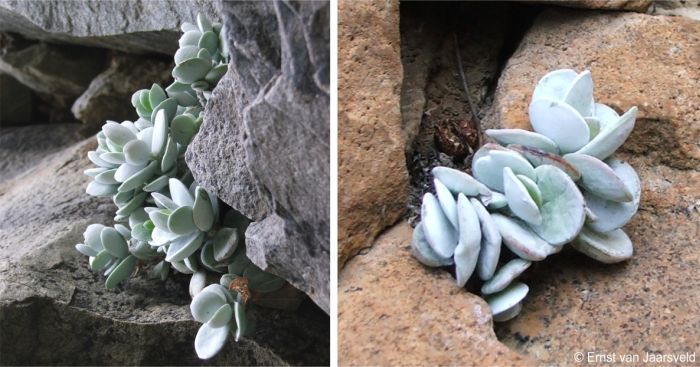
Rate this article
Article well written and informative
Rate this plant
Is this an interesting plant?
Login to add your Comment
Back to topNot registered yet? Click here to register.